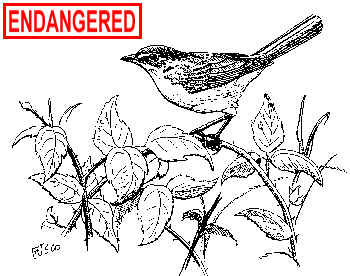Yellow-breasted Chat
Icteria virens

Habitat: Woodland edges; dense thickets, especially of briers and brambles; shrubby old fields, stream thickets and swamp margins.
Weight: 1 ounce.
Length: 7 inches.
Wingspan: 9.5 inches.
Life Expectancy: 5-8 years of age.
Food: Primarily insects, including bees, wasps, ants, grasshoppers and beetles; also berries and wild grapes.
Status: State endangered.
Identification: The yellow-breasted chat is a member of the wood warbler family. However, its body is stouter and the tail is longer than other family members. Adult chats have a bright yellow throat and breast, olive-green back, white eye rings and white whisker stripes. The bill is stout, large, curved and usually solid black. The lores (the area between the bill and the eye) are black in males and gray in females; otherwise, the sexes are similar in appearance.
Range: The yellow-breasted chat ranges from southern Canada and British Columbia east to southern New Hampshire and south to northern Florida, the Gulf Coast and Baja, California. The species winters from southern Texas and central Mexico south through the Yucatan to western Panama.
Reproduction: The breeding season is from mid-April to mid-May. The nest is built in small bushes or in tangles of vines or briers, 2 to 8 feet above ground. It is cup-shaped and made of coarse grasses, weeds, grapevine bark and dead leaves, with a lining of fine grasses. The 3 to 5 eggs are white, smooth and slightly glossy, occasionally spotted with chestnut-red to red-purple. Incubation lasts for 11 to 15 days. The young are tended by both parents and leave the nest 8 to 11 days after hatching.
Reason for Decline: The chat is a bird of successional habitat, overgrown fields and abundant thickets. As farmlands and pastures disappeared and reverted to forests or were developed for human occupation or commercial use, populations of chats declined.
History in Connecticut: The yellow-breasted chat was considered a common summer resident in Connecticut from the late 1800s through the early 1920s. It declined in northern Connecticut through the 1930s and 1940s and was considered a rare nester in all but the southern regions of the state. Chat population numbers have dropped drastically throughout much of the species' eastern range.
Interesting Facts: The scientific name describes this bird’s appearance. The genus name, Icteria, is derived from the Greek word for jaundice or yellowness, and the species name, virens, is Latin for "becoming green."
The chat’s medley of strange whistles, catcalls and musical notes has led to a debate as to whether the bird is a true mimic like mockingbirds and catbirds which sing other species' songs. During courtship, the male sings from a conspicuous perch and also performs a hovering display flight with its head raised and its legs extended toward the ground, all the while singing a complex song. The bird hovers and then drops back to the perch. Chats will also sing at night.
Yellow-breasted chat nests are often parasitized by brown-headed cowbirds. In some locations, the chats are even the chief victim of the cowbird’s egg-switching activities, in which the cowbird removes the eggs of the chat after laying her own eggs in the nest. Because of the cowbird, many yellow-breasted chats desert their nests.
Protective Legislation: Federal - Migratory Bird Treaty Act of 1918. State - Connecticut General Statutes Sec. 26-311.
What You Can Do: Habitat management that creates shrub or hedge rows or thickets of raspberry, rose or greenbrier will provide nesting locations for the chat. Maintaining old field, farm and pasture habitats is one of the best ways to help this species.

The production of this Endangered and Threatened Species Fact Sheet
Series is made possible by donations to the Endangered Species/Wildlife Income Tax
Checkoff Fund.
(rev. 12/99)

